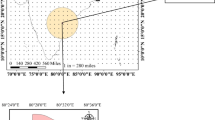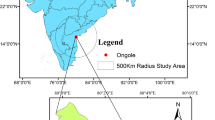Abstract
The Indian state of Haryana is in a phase of rapid industrial development. In order to help engineers and town planners in designing earthquake resistant structures, it is necessary to carry out site specific seismic hazard analysis and plan mitigation measures. It is apprehended that Indian Code generalises the design peak ground acceleration values which may underestimate the seismic loading in high seismicity regions. Therefore, it is necessary to develop regional seismic hazard scenario in line with the local seismotectonic setting which is consistent with other seismic codes worldwide. In all, 12 seismogenic sources have been identified in the seismic study area. The maximum magnitude has been assigned to each seismogenic source considering regional rupture character. Ground motion prediction equation developed for Indo-Gangetic region by National Disaster Management Authority of India has been used. The peak ground acceleration along with response spectrum for A-type sites for the state have been estimated using state of the art in deterministic seismic hazard analysis methodology. These determined strong motion parameters have been compared with the values given in Indian Standard for criteria for earthquake resistant design of structures to validate them for further practical use. The prepared spectra can be further used to quantify seismic loading for designing earthquake resistant structures in Haryana.




Similar content being viewed by others
Abbreviations
- C1–C8 :
-
Site coefficients
- DSHA:
-
Deterministic seismic hazard analysis
- GBF:
-
Great Boundary Fault
- GMPE:
-
Ground motion prediction equation
- JMT:
-
Jwala Mukhi Thrust
- KFS:
-
Kaurik Fault System
- MBT:
-
Main Boundary Thrust
- MCT:
-
Main Crustral Thrust
- MDF:
-
Moradabad Fault
- MDSSF:
-
Mahendragarh-Dehradun Sub Surface Fault
- MF:
-
Mathura fault
- Mmax :
-
Maximum magnitude potential
- MObs :
-
Maximum observed magnitude
- Mw :
-
Moment magnitude
- PFR:
-
Percentage fault rupture
- PGA:
-
Peak ground acceleration
- PGAmax :
-
PGA at a grid point corresponding to controlling earthquake
- PSHA:
-
Probabilistic seismic hazard analysis
- PSA:
-
Peak spectral acceleration
- r:
-
Hypocentral distance
- RLD:
-
Subsurface rupture length
- RT:
-
Ramgarh Thrust
- SA:
-
Spectral acceleration \( \frac{{S_{a} }}{g} \)
- SHA:
-
Seismic hazard analysis
- SLDR:
-
Sargodha-Lahore-Delhi-Ridge
- SNF:
-
Sundar Nagar Fault
- SSF:
-
Sardar Shahar Fault
- TFL:
-
Total fault length
References
Iyengar RN et al (2011) Development of probabilistic seismic hazard map of India. Technical report. National Disaster Management Authority (NDMA), Govt. of India, New Delhi
Kolathayar S, Sitharam TG, Vipin KS (2012) Deterministic seismic hazard macrozonation of India. J Earth Syst Sci 121(5):1351–1364
Naik N, Choudhury D (2015) Deterministic seismic hazard analysis considering different seismicity levels for the state of Goa. India Nat Hazards 75(1):557–580
Shukla J, Choudhury D (2012) Estimation of seismic ground motions using deterministic approach for major cities of Gujarat. Nat Hazards Earth Syst Sci 12:2019–2037
Iyengar RN and Ghosh S (2004) Seismic hazard mapping of Delhi city. In: Proceedings of 13th world conference on earthquake engineering. Vancouver, B.C., Canada. Paper No. 180
Sitharam TG, Sil A (2014) Comprehensive seismic hazard assessment of Tripura and Mizoram states. J Earth Syst Sci 123(4):837–857
Sharma ML, Wason HR, Dimri R (2003) Seismic zonation of Delhi region for bedrock ground motion. Pure appl Geophys 160(2):2381–2398
Vipin KS, Anbazhagan P, Sitharam TG (2009) Estimation of peak ground acceleration and spectral acceleration for South India with local site effects: probabilistic approach. Nat Hazards Earth Syst Sci 9:865–878
IS:1893-Part1 (2002) Indian standard criteria for earthquake resistant design of structures, Part 1: General provisions and building. Bureau of Indian Standards, New Delhi
Iyengar RN, Ghosh S (2004) Microzonation of earthquake hazard in greater Delhi region. Curr Sci 87(9):1193–1202
Dasgupta S et al (2000) Seismotectonic atlas of India and its environs (SEISAT). Geological Survey of India, Calcutta
Gupta AK, Chopra S, Prajapati SK, Sutar AK, Bansal BK (2013) Intensity distribution of M4.9 Haryana-Delhi border earthquake. Nat Hazards 68(2):405–417
Bansal BK, Verma M (2012) The M4.9 Delhi earthquake of 5 March 2012. Curr Sci 102(12):1704–1708
Shukla AK, Prakash R, Singh RK, Mishra PS, Bhatnagar AK (2007) Seismotectonic implications of Delhi region through fault plane solutions of some recent earthquakes. Curr Sci 93(12):1848–1853
Singh SK, Kumar A, Suresh G, Ordaz M, Pacheco JF, Sharma ML, Bansal BK, Dattatrayam RS, Reinoso E (2010) Delhi earthquake of 25 November 2007 (Mw 4.1): implications for seismic hazard. Curr Sci 99(7):939–947
Srivastava LS and Somayajulu JG (1966) The seismicity of the area around Delhi. In: Proceedings of the 3rd symposium on earthquake engineering, vol 1. Roorkee, pp 417–422
Prakash R, Shrivastava JP (2012) A review of seismicity and seismotectonics of Delhi and adjoining areas. J Geol Soc India 79:603–617
Mittal H, Kumar A, Ramhmachhuani R (2012) Indian national strong motion instrumentation network and site characterization of its stations. Int J Geosci 3:1151–1167
Sati D, Nautiyal SP (1994) Possible role of Delhi-Haridwar subsurface ridge in generation of Uttarkashi earthquake, Garhwal Himalaya. India Curr Sci 67(1):39–44
Anbazhagan P, Bajaj K, Moustafa Sayed SR, Al-Arifi NSN (2015) Maximum magnitude estimation considering the regional rupture character. J Seismol 19(3):695–719
Wells DL, Coppersmith KJ (1994) New empirical relationships among magnitude, rupture length, rupture area, and surface displacement. Bull Seismol Soc Am 84(4):974–1002
NRSC Data Centre (2014) Bhuvan 2D. National Remote Sensing Centre, Department of Space, Government of India, Balanagar, Hyderabad. http://bhuvan.nrsc.gov.in/map/bhuvannew/bhuvan2d.php. Accessed 29 Novemb 2014
Acknowledgments
Authors would like to acknowledge Department of Science and Technology (DST), Ministry of Science and Technology, India for providing financial assistance to carry out the study under INSPIRE Fellowship Scheme (Candidate Code IF130892). Authors are thankful to Indian Meteorological Department (IMD), Delhi for providing data for preparing earthquake catalogue of the study region. Authors thank the anonymous reviewers for their valuable comments towards improving the quality of the manuscript.
Author information
Authors and Affiliations
Corresponding author
Rights and permissions
About this article
Cite this article
Puri, N., Jain, A. Deterministic Seismic Hazard Analysis for the State of Haryana, India. Indian Geotech J 46, 164–174 (2016). https://doi.org/10.1007/s40098-015-0167-1
Received:
Accepted:
Published:
Issue Date:
DOI: https://doi.org/10.1007/s40098-015-0167-1




